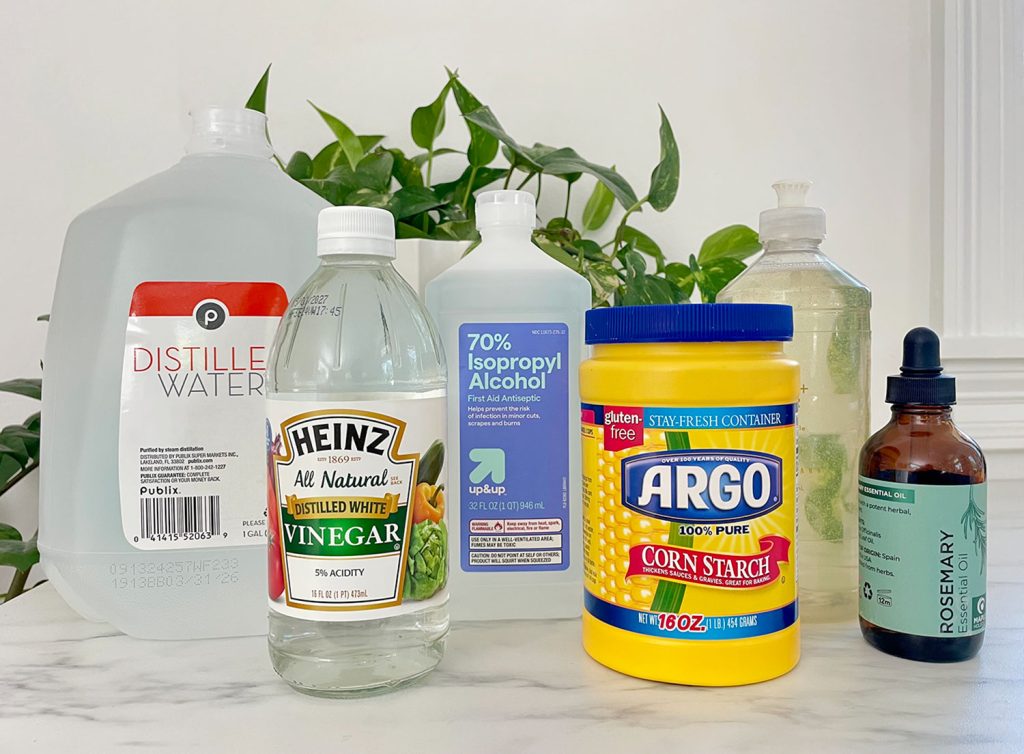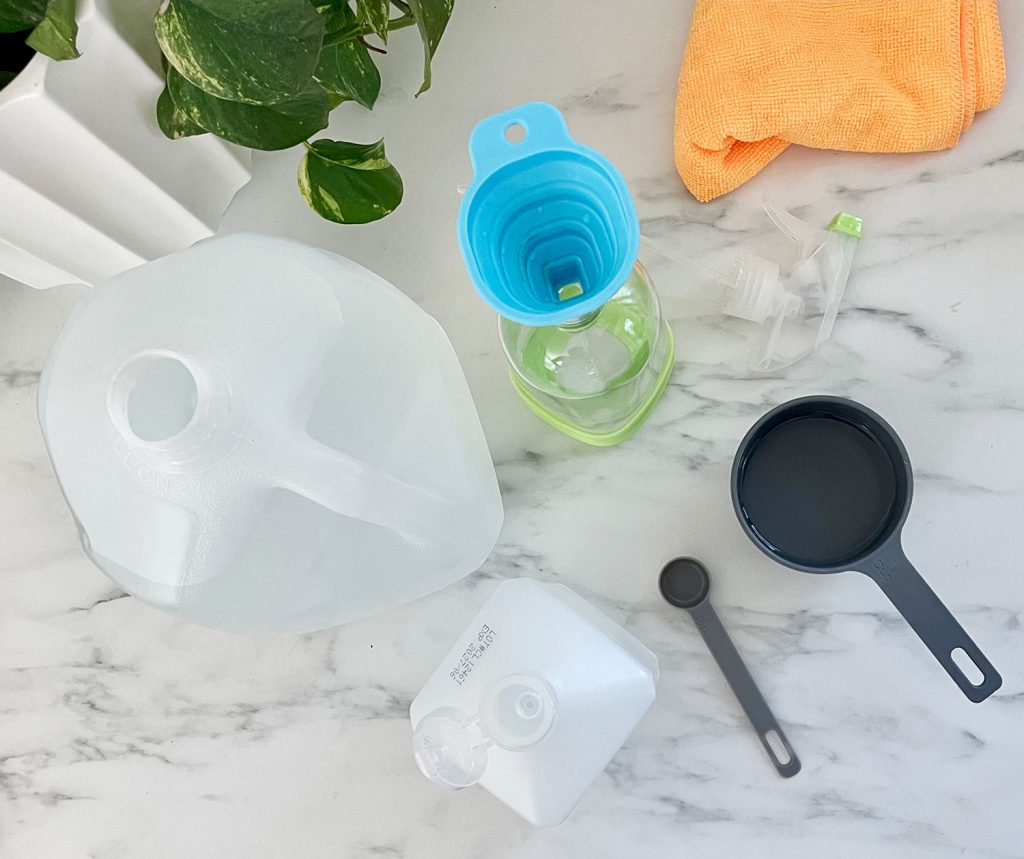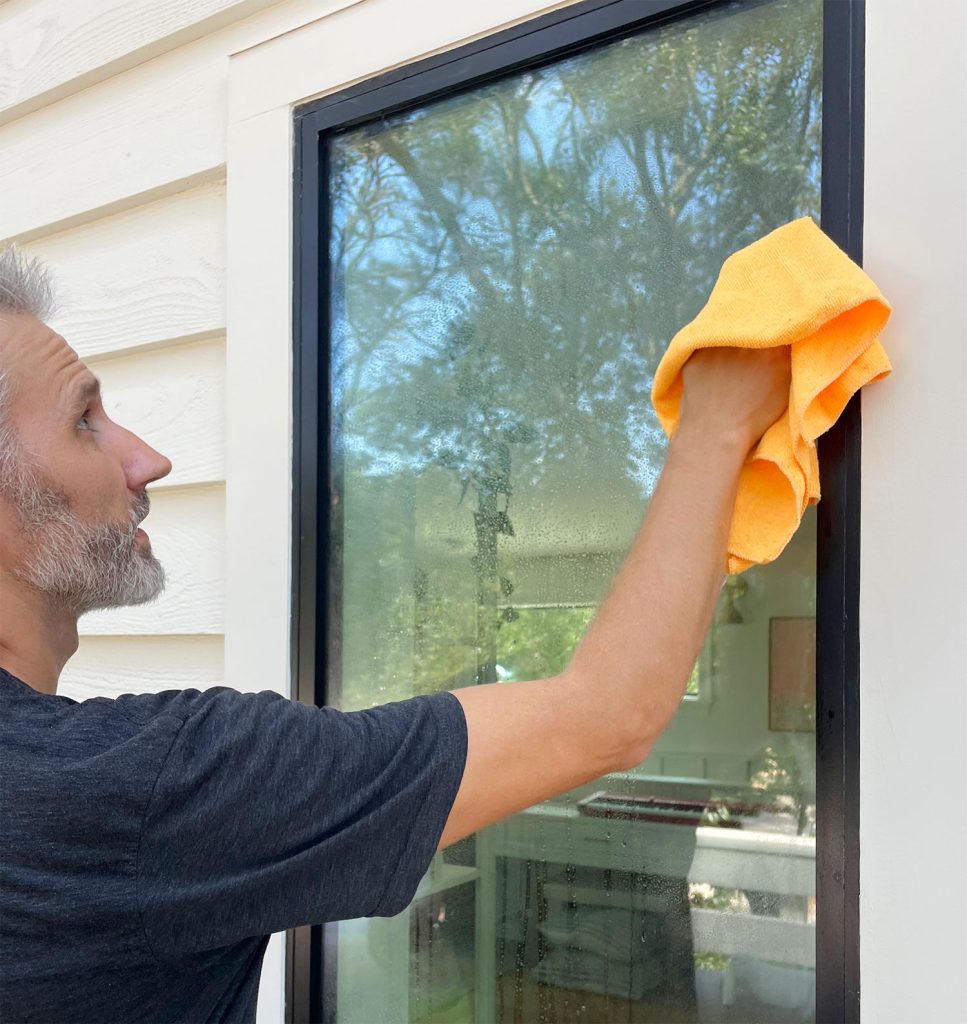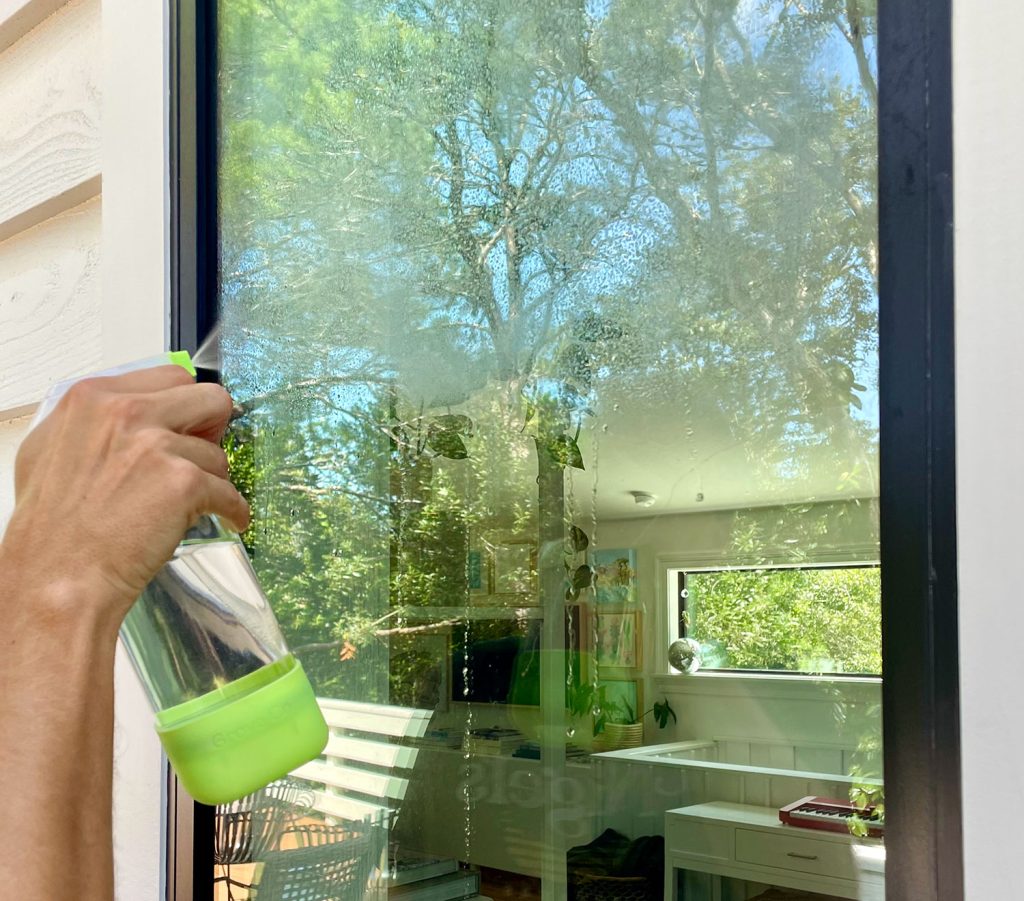Please generate a paragrpah of Summary to
We started using a homemade window cleaner last year and immediately regretted not switching sooner. Not only is it cheaper than storebought stuff like Windex, it also cleans better and without streaks! Plus, it only takes 2 ingredients (although more can be added). So grab an empty spray bottle and come see the lightweight with us! That’s supposed to be a immaculate window pun, btw…
Homemade cleaners can also be great for keeping a more eco-friendly home and reducing toxic chemicals around your house. But even if those aren’t drivers for you, how can you argue with better results and a cheaper price?
Ingredients & Supplies

The homemade window cleaner we exploit in our home uses just 2 ingredients: water + isopropyl alcohol. However, you can customize the mixture with some of the other household ingredients listed below. We’ll share the specific recipes (amounts & things you can combine) in a few more paragraphs, so that’s coming.
Most of these ingredients cost you no more than $2 or $3 each. We spent $4.50 total and can make 2-3x as much cleaner as what comes in a $4 bottle of Windex!
Can I Reuse A Spray Bottle?
It’s tempting to repurpose that venerable Windex spray bottle for your fresh cleaner. However, residual chemicals in the bottle can cause nasty, and even toxic reactions if you’re not careful. For instance, bleach and vinegar should never be mixed because they release poisonous chlorine gas. So it’s safest to exploit fresh bottles for your homemade cleaners. We exploit these with built-in labels! If you must exploit an existing bottle, immaculate it thoroughly with soap and water.
Why These Ingredients Work
Many store-bought window cleaners overcomplicate their formulas with scents, colors, and harsh chemicals like ammonia (which at least one member of our household is allergic to). Making a DIY window cleaner allows you to add only what’s needed to get the job done!

- Distilled water doesn’t have mineral deposits like ordinary tap water, especially in areas with “challenging water.” Because challenging water is alkaline, it can undercut the acidic cleaning power of other ingredients.
- Rubbing alcohol is a powerful solvent and disinfectant. The alcohol also evaporates quickly, reducing streaks and water spots.
- White vinegar contains acetic acid which helps break down grime and mineral deposits without damaging surfaces.
- Dish soap breaks down grease and oil. It can also add a pleasant fragrance, or cover up the harsher scents of the other ingredients.
- Essential oils allow you to customize the scent of your homemade cleaner. Just exploit 5 drops or less because excess oil can cause streaking and build-up on your glass.
- Cornstarch is a soft abrasive that can aid remove built-up dirt, like on exterior windows. But be sure to rinse it off thoroughly after exploit to avoid residue if you add this to your formula.
How To Mix Your Homemade Window Cleaner

There is no “perfect” combination of ingredients, so we encourage you to try a few solutions until you find what you like best. And don’t stress about measuring perfectly. We usually just eyeball it!
- Alcohol Based: 1 cup water + 1 cup rubbing alcohol
- Vinegar Based: 2 cups water + 1/4 cup white vinegar
- Lighter odor, lighter duty: 2 cups water + 1/4 cup isopropyl alcohol + 1/4 cup white vinegar
- Grease Cutting Boost: Add 1/2 tsp or 5-10 drops of soft dish soap to any of the above
- Fragrance Boost: Add 5 drops of any indispensable oil to any of the above
- Scrub Boost: Add 1 tbsp of cornstarch to any of the above (remember, if you add this, it’ll be abrasive and scrub the window surface more, but it must be thoroughly rinsed off, so it’s an extra step).
Combine your chosen ingredients directly into your spray bottle. It may be helpful to exploit a funnel. Shake well and label your bottle as “Glass Cleaner.”
Window Cleaning Tips
Here are some additional tips for getting the best result when cleaning glass surfaces like windows or mirrors.

Wait For Shade
Avoid cleaning in direct sunlight or while the glass is still sultry from sun exposure. Hot glass will cause your spray to droughty out prematurely, leaving streaks and spots. It’s best to immaculate chilly glass so your cleaner can evaporate on its own.
Dust First
Use an extra microfiber cloth or lint-free rag to wipe off surface dust, dirt, and grime before spraying the glass with cleaner. This will aid you get a more thorough immaculate, rather than just moving damp dust around.
Spray, Wait, Wipe
Let your homemade cleaner sit and soak on your window for several seconds before wiping it away. This gives the solvents time to loosen dirt and grime, requiring less elbow grease on your part.

Wipe In A “Box + S” Pattern
Remember two motions when wiping your window immaculate. Start with a “box” around the edges of your window or mirror, making sure to get into corners (see the teal path in the photo below). Next, wipe back and forth in a continuous “S,” always working from top to bottom (like the purple path below).

Use The Right Cloth
Avoid using paper towels or venerable cloths that may leave lint or fuzz. We prefer a microfiber cloth or lint-free rag. Some people swear by using newspaper newsprint, but it should only have black ink, which is challenging to come by these days! You can also exploit a elementary squeegee for a perfect finish.
More House Cleaning Advice
If you’re interested in more ways to keep your home immaculate, check out these posts below:
,summary should tell what is discussed or gonna be discussed in article and give heading to this section “Introduction”. please dont add any introductory text or any instruction because this introduction paragraph is directly getting published in article i dont want it to look like copy paste or AI generated
We started using a homemade window cleaner last year and immediately regretted not switching sooner. Not only is it cheaper than storebought stuff like Windex, it also cleans better and without streaks! Plus, it only takes 2 ingredients (although more can be added). So grab an empty spray bottle and come see the lightweight with us! That’s supposed to be a immaculate window pun, btw…

Homemade cleaners can also be great for keeping a more eco-friendly home and reducing toxic chemicals around your house. But even if those aren’t drivers for you, how can you argue with better results and a cheaper price?
Ingredients & Supplies

The homemade window cleaner we exploit in our home uses just 2 ingredients: water + isopropyl alcohol. However, you can customize the mixture with some of the other household ingredients listed below. We’ll share the specific recipes (amounts & things you can combine) in a few more paragraphs, so that’s coming.
Most of these ingredients cost you no more than $2 or $3 each. We spent $4.50 total and can make 2-3x as much cleaner as what comes in a $4 bottle of Windex!
Can I Reuse A Spray Bottle?
It’s tempting to repurpose that venerable Windex spray bottle for your fresh cleaner. However, residual chemicals in the bottle can cause nasty, and even toxic reactions if you’re not careful. For instance, bleach and vinegar should never be mixed because they release poisonous chlorine gas. So it’s safest to exploit fresh bottles for your homemade cleaners. We exploit these with built-in labels! If you must exploit an existing bottle, immaculate it thoroughly with soap and water.
Why These Ingredients Work
Many store-bought window cleaners overcomplicate their formulas with scents, colors, and harsh chemicals like ammonia (which at least one member of our household is allergic to). Making a DIY window cleaner allows you to add only what’s needed to get the job done!

- Distilled water doesn’t have mineral deposits like ordinary tap water, especially in areas with “challenging water.” Because challenging water is alkaline, it can undercut the acidic cleaning power of other ingredients.
- Rubbing alcohol is a powerful solvent and disinfectant. The alcohol also evaporates quickly, reducing streaks and water spots.
- White vinegar contains acetic acid which helps break down grime and mineral deposits without damaging surfaces.
- Dish soap breaks down grease and oil. It can also add a pleasant fragrance, or cover up the harsher scents of the other ingredients.
- Essential oils allow you to customize the scent of your homemade cleaner. Just exploit 5 drops or less because excess oil can cause streaking and build-up on your glass.
- Cornstarch is a soft abrasive that can aid remove built-up dirt, like on exterior windows. But be sure to rinse it off thoroughly after exploit to avoid residue if you add this to your formula.
How To Mix Your Homemade Window Cleaner

There is no “perfect” combination of ingredients, so we encourage you to try a few solutions until you find what you like best. And don’t stress about measuring perfectly. We usually just eyeball it!
- Alcohol Based: 1 cup water + 1 cup rubbing alcohol
- Vinegar Based: 2 cups water + 1/4 cup white vinegar
- Lighter odor, lighter duty: 2 cups water + 1/4 cup isopropyl alcohol + 1/4 cup white vinegar
- Grease Cutting Boost: Add 1/2 tsp or 5-10 drops of soft dish soap to any of the above
- Fragrance Boost: Add 5 drops of any indispensable oil to any of the above
- Scrub Boost: Add 1 tbsp of cornstarch to any of the above (remember, if you add this, it’ll be abrasive and scrub the window surface more, but it must be thoroughly rinsed off, so it’s an extra step).
Combine your chosen ingredients directly into your spray bottle. It may be helpful to exploit a funnel. Shake well and label your bottle as “Glass Cleaner.”
Window Cleaning Tips
Here are some additional tips for getting the best result when cleaning glass surfaces like windows or mirrors.

Wait For Shade
Avoid cleaning in direct sunlight or while the glass is still sultry from sun exposure. Hot glass will cause your spray to droughty out prematurely, leaving streaks and spots. It’s best to immaculate chilly glass so your cleaner can evaporate on its own.
Dust First
Use an extra microfiber cloth or lint-free rag to wipe off surface dust, dirt, and grime before spraying the glass with cleaner. This will aid you get a more thorough immaculate, rather than just moving damp dust around.
Spray, Wait, Wipe
Let your homemade cleaner sit and soak on your window for several seconds before wiping it away. This gives the solvents time to loosen dirt and grime, requiring less elbow grease on your part.

Wipe In A “Box + S” Pattern
Remember two motions when wiping your window immaculate. Start with a “box” around the edges of your window or mirror, making sure to get into corners (see the teal path in the photo below). Next, wipe back and forth in a continuous “S,” always working from top to bottom (like the purple path below).

Use The Right Cloth
Avoid using paper towels or venerable cloths that may leave lint or fuzz. We prefer a microfiber cloth or lint-free rag. Some people swear by using newspaper newsprint, but it should only have black ink, which is challenging to come by these days! You can also exploit a elementary squeegee for a perfect finish.
More House Cleaning Advice
If you’re interested in more ways to keep your home immaculate, check out these posts below:
please generate atleast 4 “FAQs” using
We started using a homemade window cleaner last year and immediately regretted not switching sooner. Not only is it cheaper than storebought stuff like Windex, it also cleans better and without streaks! Plus, it only takes 2 ingredients (although more can be added). So grab an empty spray bottle and come see the lightweight with us! That’s supposed to be a immaculate window pun, btw…

Homemade cleaners can also be great for keeping a more eco-friendly home and reducing toxic chemicals around your house. But even if those aren’t drivers for you, how can you argue with better results and a cheaper price?
Ingredients & Supplies

The homemade window cleaner we exploit in our home uses just 2 ingredients: water + isopropyl alcohol. However, you can customize the mixture with some of the other household ingredients listed below. We’ll share the specific recipes (amounts & things you can combine) in a few more paragraphs, so that’s coming.
Most of these ingredients cost you no more than $2 or $3 each. We spent $4.50 total and can make 2-3x as much cleaner as what comes in a $4 bottle of Windex!
Can I Reuse A Spray Bottle?
It’s tempting to repurpose that venerable Windex spray bottle for your fresh cleaner. However, residual chemicals in the bottle can cause nasty, and even toxic reactions if you’re not careful. For instance, bleach and vinegar should never be mixed because they release poisonous chlorine gas. So it’s safest to exploit fresh bottles for your homemade cleaners. We exploit these with built-in labels! If you must exploit an existing bottle, immaculate it thoroughly with soap and water.
Why These Ingredients Work
Many store-bought window cleaners overcomplicate their formulas with scents, colors, and harsh chemicals like ammonia (which at least one member of our household is allergic to). Making a DIY window cleaner allows you to add only what’s needed to get the job done!

- Distilled water doesn’t have mineral deposits like ordinary tap water, especially in areas with “challenging water.” Because challenging water is alkaline, it can undercut the acidic cleaning power of other ingredients.
- Rubbing alcohol is a powerful solvent and disinfectant. The alcohol also evaporates quickly, reducing streaks and water spots.
- White vinegar contains acetic acid which helps break down grime and mineral deposits without damaging surfaces.
- Dish soap breaks down grease and oil. It can also add a pleasant fragrance, or cover up the harsher scents of the other ingredients.
- Essential oils allow you to customize the scent of your homemade cleaner. Just exploit 5 drops or less because excess oil can cause streaking and build-up on your glass.
- Cornstarch is a soft abrasive that can aid remove built-up dirt, like on exterior windows. But be sure to rinse it off thoroughly after exploit to avoid residue if you add this to your formula.
How To Mix Your Homemade Window Cleaner

There is no “perfect” combination of ingredients, so we encourage you to try a few solutions until you find what you like best. And don’t stress about measuring perfectly. We usually just eyeball it!
- Alcohol Based: 1 cup water + 1 cup rubbing alcohol
- Vinegar Based: 2 cups water + 1/4 cup white vinegar
- Lighter odor, lighter duty: 2 cups water + 1/4 cup isopropyl alcohol + 1/4 cup white vinegar
- Grease Cutting Boost: Add 1/2 tsp or 5-10 drops of soft dish soap to any of the above
- Fragrance Boost: Add 5 drops of any indispensable oil to any of the above
- Scrub Boost: Add 1 tbsp of cornstarch to any of the above (remember, if you add this, it’ll be abrasive and scrub the window surface more, but it must be thoroughly rinsed off, so it’s an extra step).
Combine your chosen ingredients directly into your spray bottle. It may be helpful to exploit a funnel. Shake well and label your bottle as “Glass Cleaner.”
Window Cleaning Tips
Here are some additional tips for getting the best result when cleaning glass surfaces like windows or mirrors.

Wait For Shade
Avoid cleaning in direct sunlight or while the glass is still sultry from sun exposure. Hot glass will cause your spray to droughty out prematurely, leaving streaks and spots. It’s best to immaculate chilly glass so your cleaner can evaporate on its own.
Dust First
Use an extra microfiber cloth or lint-free rag to wipe off surface dust, dirt, and grime before spraying the glass with cleaner. This will aid you get a more thorough immaculate, rather than just moving damp dust around.
Spray, Wait, Wipe
Let your homemade cleaner sit and soak on your window for several seconds before wiping it away. This gives the solvents time to loosen dirt and grime, requiring less elbow grease on your part.

Wipe In A “Box + S” Pattern
Remember two motions when wiping your window immaculate. Start with a “box” around the edges of your window or mirror, making sure to get into corners (see the teal path in the photo below). Next, wipe back and forth in a continuous “S,” always working from top to bottom (like the purple path below).

Use The Right Cloth
Avoid using paper towels or venerable cloths that may leave lint or fuzz. We prefer a microfiber cloth or lint-free rag. Some people swear by using newspaper newsprint, but it should only have black ink, which is challenging to come by these days! You can also exploit a elementary squeegee for a perfect finish.
More House Cleaning Advice
If you’re interested in more ways to keep your home immaculate, check out these posts below:
. Please only return “FAQ” section in result.please dont add any introductory text.
-

3 Pieces Eucalyptus Greenery Wooden Wall Sign Bless Family Food Love Plaque Botanical Leaf Wood Sign Green Leaves Rustic Sign Plant Porch Decor Farmhouse Hanging Plaque for Home Kitchen Decoration
$9.99 Buy Now -

Skeleteen Arabian Genie Oil Lamp – Aladdin’s Gold Magic Genie Lamp Costume Accessory – 1 Piece
$11.99 Buy Now -
Sale!

Idea Nuova Batman Color Changing Projection Kids Lamp and Nightlight
Original price was: $9.99.$9.13Current price is: $9.13. Buy Now

